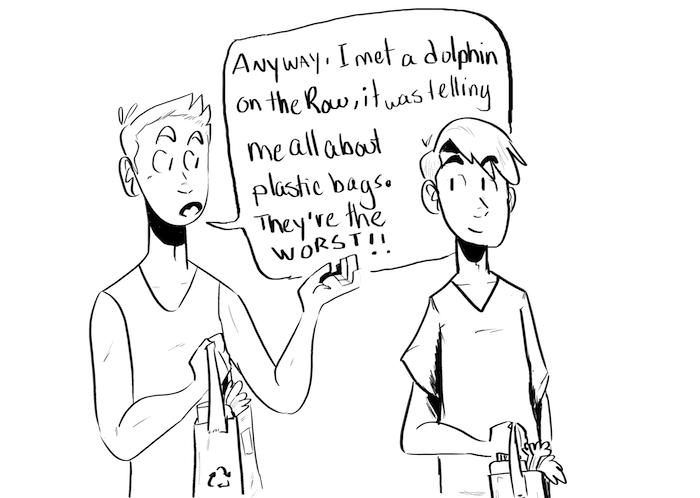My family and I visited the Monterey Bay Aquarium in Monterey, California two years ago to enjoy beautiful views of the bay and explore the diverse array of sea creatures on display there. The aquarium also doubles as a marine research institute, which releases public information on environmental issues affecting marine life, such as the harmful effects of plastic bag use. While there, I decided to buy myself a small souvenir: a little magnet half the size of my palm. It was here that I encountered a plastic bag ban for the first time. Now that I think about it, why would I have even needed a plastic bag to carry something I could have easily slipped into my pocket?
California became the first state to pass legislation banning the use of single-use lightweight plastic shopping bags last month, bringing the state in line with roughly 100 small towns and large cities in the state that have enacted a municipal ban, including Monterey and more recently, my hometown of Los Altos. For many Americans, however, news of the plastic bag ban in the nation’s most populous state may come as a shock. After all, these thin, lightweight pieces of plastic have been ubiquitous staples of American life for decades. But that may change soon.
The worldwide trend has been gradually shifting away from plastic shopping bags ever since the infamous North Pacific Gyre was discovered in 1997, and with its discovery came a massive collection of floating debris. While other things might biodegrade, in water, plastics will only decompose into smaller and smaller pieces until it enters the marine food chain. So when we eat seafood, we are also often eating plastic materials. In 2002, Bangladesh became the first country to institute a nationwide ban after plastic bags clogged the nation’s drainpipes, causing massive flooding. China followed suit in 2008, just months before the Beijing Olympics. Additionally, many European countries levy a fee on each plastic bag used, incentivizing consumers to carry their purchases home by hand or with reusable cloth bags. All told, nearly 25 percent of the world’s population now live in a jurisdiction with a plastic bag ban or tax.
The hard truth is that consumers worldwide use an estimated two million plastic bags every minute before discarding them, on average, only 12 minutes later. From that moment, the bags begin a thousand-year long tour to the farthest reaches of the world before they should theoretically decompose. They have been found in the stomachs of beached whales, blowing in the winds of Mount Everest and dirtying up beaches all over the world. In 2009, the United Nations Environmental Programme declared that there “is simply zero justification for manufacturing [thin, single-use plastic bags] anymore, anywhere.”
Plastic bag manufacturers’ response to these concerns is to encourage consumers to recycle them. Oregon’s legislature was poised to consider a bill two years ago that would have banned plastic bags in the state. In response, the bag manufacturers lobbied state politicians by perpetuating the myth that plastic bags can be recycled. They even promised to build a new plastic recycling facility in the state. But plastic bags are made with such ultra-thin material – thinner than a strand of human hair – that plastic recycling machines are unable to process them. According to Far West Fibers, the largest plastic recycling company in Oregon, an astounding 25 percent of their total labor costs are directed towards removing the 300,000 plastic bags a day that become stuck in their machines. In the end, fewer than nine percent of plastic bags are recycled.
I understand that my purchase at the Monterey Bay Aquarium was just a small magnet, and the vast majority of plastic bag consumption comes from larger purchases at retail and grocery stores. We are so accustomed to these lightweight miracle bags that can carry several pounds worth of stuff 30 yards from the checkout counter to our cars that doing away with them all of a sudden can feel like a scary prospect. But it really isn’t. I would know.
When Los Altos, along with much of the San Francisco Bay Area, enacted its own plastic bag ban last year, I initially had difficulty getting into the habit of bringing reusable bags with me when I go shopping. But then I thought about how every plastic bag that I don’t use means one less plastic bag drifting in the ocean, and I now remember to bring my canvas bag along on every grocery trip, even when I am at Emory and don’t have to.
I’ve had a handful of friends who have graduated from Emory and ended up in the San Francisco Bay Area within the past year. Not a single one has complained about having to remember to bring their canvas bags, because it really is that simple to switch! Even though Atlanta does not have a municipal plastic bag ban, you can do your part to reduce plastic bag consumption by remembering to bring your reusable canvas bag to the grocery store every week. And for those of you who take the Emory shuttle to Kroger for your groceries, one good canvas bag can carry the worth of three to four plastic bags, making your life easier on the crowded bus!
Taking these small steps can have instant, positive ramifications on our environment. Before my switch to reusable bags, I could use up to four or five plastic bags on each trip to the grocery store. Over the course of a year, that could be over 200 plastic bags that I contributed to some ecological disaster like the North Pacific Gyre. Now, that number is zero. Adjusting this small habit was so easy and painless that it is hard to believe how much better off the environment is because of it. I encourage you to try bringing a canvas bag to the grocery store next time, and think about all of the bags you saved from ending up where they could cause so much harm.
– Edmund Xu is a College senior from Los Altos, California.
The Emory Wheel was founded in 1919 and is currently the only independent, student-run newspaper of Emory University. The Wheel publishes weekly on Wednesdays during the academic year, except during University holidays and scheduled publication intermissions.
The Wheel is financially and editorially independent from the University. All of its content is generated by the Wheel’s more than 100 student staff members and contributing writers, and its printing costs are covered by profits from self-generated advertising sales.






